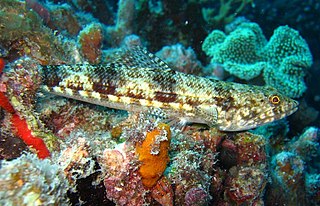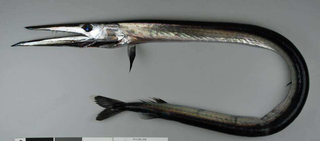
Barracudinas are any member of the marine mesopelagic fish family Paralepididae: 50 or so extant species are found almost worldwide in deep waters. Several genera are known only from fossils dating back to the Ypresian epoch.

Aulopiformes is a diverse order of marine ray-finned fish consisting of some 15 extant and several prehistoric families with about 45 genera and over 230 species. The common names grinners, lizardfishes and allies, or aulopiforms are sometimes used for this group. The scientific name means "Aulopus-shaped", from Aulopus + the standard fish order suffix "-formes". It ultimately derives from Ancient Greek aulós + Latin forma, the former in reference to the elongated shape of many aulopiforms.

Fangtooths are beryciform fish of the family Anoplogastridae that live in the deep sea. The name is from the Greek anoplo, meaning "unarmed", and γαστήρ, meaning "stomach". With a worldwide distribution in tropical and cold-temperate waters, the family contains only two very similar species in one genus, with no known close relatives.

The daggertooths are a genus of marine mesopelagic fish in the order Aulopiformes, the sole genus of the family Anotopteridae. They are found in oceans worldwide, but prefer cooler waters.
Lestidiops is a genus of barracudinas.
Paralepis is a genus of barracudinas.
Arctozenus risso, the Spotted barracudina or Ribbon barracudina, is a species of barracudina found in oceans worldwide in the meso- and bathypelagic zone down to abound 2,200 metres (7,200 ft). This species grows to a length of 30 centimetres (12 in) SL. This species is the only known member of its genus. It is an important forage species for many pelagic predators, such as cephalopods, common dolphins, and albacore.
Dolichosudis fuliginosa is a species of barracudina found in the Atlantic Ocean and Western Pacific Ocean at a depths of around 1,200 metres (3,900 ft). This species grows to a length of 24.4 centimetres (9.6 in) SL. This species is the only known member of its genus.

Lestidium is a genus of barracudina. They are sometimes referred to as pike smelt.

Lestrolepis is a genus of barracudina.
Macroparalepis is a genus of barracudinas.
Notolepis is a genus of barracudinas.

Stemonosudis is a genus of barracudinas. These are deep water fish that resemble but are not related to barracuda. They are long and slender with pointed snouts. They are hunters with large eyes and sharp teeth. Unlike barracuda, these fish have no swim bladder.
Sudis is a genus of barracudinas, with two currently recognized species:
Uncisudis is a genus of barracudinas.

Lestidium atlanticum, the Atlantic barracudina, is a species of fish. It is widely distributed in tropical and subtropical waters of the three major oceans. This species reaches a length of 25 cm (9.8 in).
Magnisudis atlantica, the duckbill barracudina, is a fish belonging to the genus Magnisudis of the family Paralepididae. It is a carnivorous fish that is endemic to the Atlantic Ocean and to much of the southern and northern Pacific Ocean.
The sharpchin barracudina is a species of fish in the family Paralepididae (barracudinas).
Lestidium australis is a species of fish. It is found in Eastern Australia.
Lestidium longilucifer is a species of fish. It is found in Western Australia and Taiwan.






